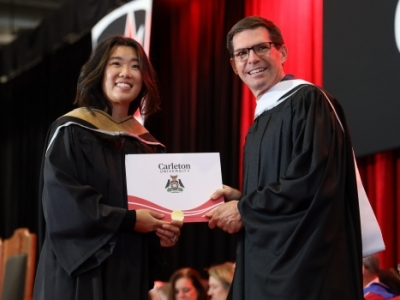
Photo credit: Peter Pallister
Carleton is known for its collaborative initiatives. One such project is called the Multimodal Optical Sensors, Applications, Interfaces, and Controls (MOSAIC) project. Quite a mouthful that is producing amazing research.
MOSAIC is a fibre optic sensing technology combined with nanoscience in the Department of Chemistry to build better sensors that will have important biomedical and environmental research applications. This NSERC-funded project is led by Electronics Professor Jacques Albert.
David Mandia was looking for this kind of research to focus on during his PhD. So he chose Carleton because of the research and the opportunity to work with renowned professors like Albert and Chemistry Professor Sean Barry.
And now Mandia’s research has just won him a $3,000 Optics and Photonics Education Scholarship from SPIE, the international society for optics and photonics.
Barry’s CFI-funded Lab adapted optical fiber-based devices, developed by the MOSAIC team, to create extremely thin and optically-interesting metallic films on metals. The Barry lab specializes in thin gold films by vapour deposition methods.
Ultimately, this research is leading to the development of robust, versatile and tiny sensors that can have many applications for electronics, solar applications, or microelectronics.
Continues Mandia: “We envision that these sensors can be used for many applications, which include the detection of harmful gases such as hydrogen sulfide or small molecules such as cancer proteins. Since we are dealing with the interaction of light with matter on the atomic scale, extremely good sensitivities are easily achieved.”
“This particular research has garnered a lot of interest already and the Barry Lab has collaborated with colleagues in Canada, the U.S. and Europe on a regular basis,” says Mandia. “What’s even more encouraging is the inception of what will be a world-class facility in surface science, called the Facility for Nanoscience, Surfaces and Sensor Interfaces (FANSSI), introduced just this spring at Carleton.”
Mandia recently visited the Cornell University High Energy Synchrotron Source where he used an ensemble of hard x-ray techniques to characterize some of his ultrathin gold films.
He plans on using his SPIE funds to offset the cost of attending SPIE Photonics West 2015 and other conferences in the near future.
Mandia says he is grateful to his colleagues in the Barry Lab “for helping foster such an insightful and enjoyable lab environment. I would like to especially acknowledge my principal collaborator, Wenjun Zhou, who is a PhD candidate for Professor Albert in the Department of Electronics.”

Jacques Albert and Wenjun Zhou
In fact, Zhou also just won an award – a $6,000 (U.S.) Chinese Government Award “for Outstanding Self-Financed Students Abroad” from the China Scholarship Council (CSC). The award was presented at a reception at the Chinese Embassy in Ottawa. At the same time, Dr. Albert was given a certificate by the Ambassador Mr. Zhaohui LUO in recognition of his work as Zhou’s supervisor.
SPIE is the international society for optics and photonics, a not-for-profit organization founded in 1955 to advance light-based technologies. The Society serves nearly 256,000 constituents from approximately 155 countries, offering conferences, continuing education, books, journals, and a digital library in support of interdisciplinary information exchange, professional networking and patent precedent.
Thursday, June 26, 2014 in Awards, Grad Student Research
Share: Twitter, Facebook



